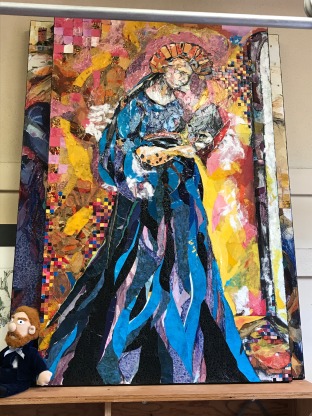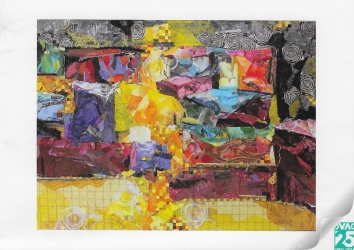 Marsha Pippenger’s determination to make art is the steel thread running throughout her career. Like many practicing artists, Marsha has held a variety of jobs, but regardless of whether she was in advertising, retail or education, art remained her focus. I asked Marsha how she crafted her career. The highlights of her story follow.
Marsha Pippenger’s determination to make art is the steel thread running throughout her career. Like many practicing artists, Marsha has held a variety of jobs, but regardless of whether she was in advertising, retail or education, art remained her focus. I asked Marsha how she crafted her career. The highlights of her story follow.
In the beginning…
Marsha Pippenger grew up in Celina, Ohio, the youngest of three. “I was by myself a lot because I am much younger than my brother and sister. I was perfectly content to play alone. I liked to read and I did a lot of drawing. I never really played with my Barbie dolls; I built them houseboats to live on and things like that…I’ve been some sort of maker most of my life.”
Marsha focused mainly on academics during high school, only taking art as an elective her senior year. College was different. “I knew when I went to college…I wanted to major in art.” She didn’t apply to any art schools, because having to submit a portfolio was daunting, and “I wanted to take other liberal arts subjects as well…that’s why I chose a university with an art department.” Ohio Northern University met her parents’ need to have her close and her desire for an art department with a “comprehensive offering of media.”
Did Marsha pursue art in college?
In college Marsha majored in art with a concentration in printmaking, but she also “took a lot of English classes. I would’ve been an English major if I hadn’t majored in art.” With four additional education classes, she graduated with a Bachelor’s in Fine Arts (BFA) and a certificate to teach art in grades K-12.
Was Marsha able to find a job using her art background?
After graduation, she worked for about a year at Cotter Advertising in Dayton doing all their commercial silk screening. “Most of the things I did were real estate signs…I also printed big yellow stars on the Montgomery County Sheriff cars.”
The following year, Marsha got married and moved several times as her husband, Alan, went to graduate school, did an internship, and got a job. Over the next six years, they lived in Ann Arbor, Michigan, Kansas City, Missouri, and Annapolis, Maryland. Marsha worked in an office supply store, art supply store, and a Scottish and Irish Imports store.
Regardless of where they lived or where Marsha was working, she persisted. “I never stopped. I was really determined about that. I wasn’t going to be one of those people who majored in art and then never did it again. That happens to a very large percentage of art majors who go off and within five years they’re not making any art.”

Marsha’s space to make art changed each time they moved. In Ann Arbor, they lived in a tiny apartment, but she was still drawing. “I kept my art supplies under the couch…so I did a lot of color pencil.”
In Kansas City, “I got my first real drawing table and a stool, so I had a place to work.” In Annapolis, Marsha started as the assistant manager at Scottish and Irish Imports, Ltd. She then became their one-person art department, primarily producing their national mail order catalog and doing “anything that required art…I was working from home…so I had a studio in the house.”
Did Marsha stay in Maryland?
After about four years in Annapolis, Marsha and Alan returned to Dayton, Ohio. Marsha got a job as a copywriter for the department store, Elder Beerman. When she went to a talk at the Dayton Society of Painters & Sculptors (now the Dayton Society of Artists), she realized she had known the speaker, Bing Davis, when he bought art supplies for a ceramic mural commission from the Kansas City art supply store where she worked.

After reconnecting with Bing Davis, Marsha decided she wanted to work with him on a Masters in Fine Art (MFA). He had formerly taught at Miami University, but Miami required MFA students to be full-time, and Marsha needed to work. Instead, she spent one and a half years in an independent study program under Bing at Central State University. “He would come to the house and critique my work, bringing his daughter, Nia, with him. She was the same age as our daughter, Laura, and they would play while we worked.”
Bing Davis encouraged Marsha to try teaching, so she renewed her certificate to teach art in grades K-12, and taught in the Dayton Public Schools at Meadowdale and Jefferson Elementary Schools.
Did Marsha keep teaching?
Marsha left elementary school teaching after four years and joined the Santa Clara Gallery artist co-op. When Santa Clara closed, she joined six other artists to start a new gallery in Tipp City, Conversation Pieces. They were “all equal partners in the gallery. We staffed it and ran the business, too…we all had to balance the accounts at the end of every day… that was really useful. I learned a lot.”

Owning the gallery was a “really great experience” from a personal as well as a business perspective. “There’s something about telling people you’re an artist…you feel kind of like a fraud…that’s not serious enough…it sounds so light. It was having the gallery that made me realize, become comfortable with the fact that, yes, this is what I do, I’m an artist… this is a job; this is a vocation, it’s not just a hobby.”
After eight years, the gallery closed in 2001 due to the economic downturn after 9/11, as well as the health and retirement issues of some of the other artists.
What did Marsha do after the gallery closed?
Marsha decided it was time to get her Master’s. Since Wright State University in Dayton doesn’t offer an MFA, she would have had to go out of town. Unable to spend that much time on the road, she got a Masters in Humanities with a focus on fine arts at Wright State instead.
“Wright State didn’t have a lot of art classes that I hadn’t already taken…so I took a couple of independent study art classes and a lot of art history. While I was taking those classes, they asked me to teach the General Education courses art history. In the morning, I was taking classes… and in the afternoon, I was teaching.”

Does Marsha still teach?
Marsha continues as an adjunct professor, teaching introductory level art history classes at Wright State. Adjunct professors teach part-time and are paid per course. Without a Ph.D., she can’t teach classes at higher levels, but she prefers the more introductory level classes anyway. ”I’ve got more freedom…I’m teaching a lot of kids who have never been to an art museum and I like that…I like to create new art lovers.”
Since she got her Master’s, Marsha has also taught at Sinclair College, Edison State Community College, and Kettering College. This fall she will also teach a class at School of Advertising Art in Dayton.She taught her first art history class at Kettering as a substitute teacher. “I did an informal survey of my students and they were really interested in a more hands-on class, so I went to the dean and made a proposal, and he said if you get enough students to pay your adjunct fee, you’ve got a class, and I’ve been teaching there ever since.”

Although she teaches big art history lecture classes at Wright State, “I’m trying to do a few hands-on things…I pantomime how to do certain things, I bring in art supplies and demonstrate, I use a lot more video…I like to throw in some of the personal quirks of some of the artists, those things help you remember…Caravaggio was always getting into fights and getting thrown into jail…makes it more memorable.”
Does Marsha still make art?
In Annapolis “when I was doing commercial art… probably because graphic design is more tightly controlled art, I felt like I was getting very tight with my work, my drawing, hunched over like Ebenezer Scrooge.”
When Marsha moved to Dayton, “I was going through that little crisis of my work becoming too tight and not free enough, and that’s when I started working with Bing.” Bing Davis suggested collage would force her to loosen up.

“I realized…I had been incorporating collage into my work all along…I might do a drawing and I’d add in some collage pieces… I think in terms of paper.”
When she first started making collages, her work was simpler, lighter and less complex. “It’s really changed a lot, gotten more complex over the years…I gravitate towards color…I’ve tried to do softer things and they always get more colorful…what I do now is more abstract.”
How does Marsha get her creative juices flowing?

“You think with your pencil…you can’t wait around for inspiration to strike… you just come in and work…some of it can be really lousy. A lot of times, it’s something I read. Ideas…words will give me ideas…that make me see pictures…or sometimes it’s a really interesting piece of paper. It’s good to set yourself some parameters. When it’s really open-ended, it’s harder to create. If you create within limitations that you set for yourself, you actually can be more creative. It’s fun to work within those limitations.”
Marsha’s observations:
-
- “Get the fundamentals – the basics of drawing and composition, because I think it’s good to start at the beginning when you’re a beginner”
- “I draw every day …I look at other artists’ work. I love looking at the old masters to see how they did it; you can really learn a lot that way. And you can see where their mistakes are!”
-

Christine…Icon, papier colle on canvas, 30″w by 48″h, Marsha Pippenger - “Knowing something about the history of what you do helps inform your own practice; then you can look back and see what previous artists have done…so teaching art history helps me in my art, too”
- “Learn about the business of art; ask questions; find an older artist to give you some help”
- Rather than giving small children art lessons, have “the materials around…so that they can have that experience of having stuff around to manipulate and play with and do… it’s that critical thinking idea”
- Sources for opportunities to apply for commissions:

-
-
- Call for Entry
- EntryThingy
- Google to find periodicals that list calls for entry and requests for proposals
- Professional artist magazines
- DVAC “is a support group for artists… helping artists to find opportunities…putting artists and business opportunities together”
- Dayton Society of Artists
- “A painting requires a little mystery, some vagueness, some fantasy. When you always make your meaning perfectly plain you end up boring people.” (Edgar Degas)
-
Recently, the Dayton Metro Library commissioned two works by Marsha to hang in the Northwest and Kettering branches as part of ReImagining Works:
You can learn more about Marsha and view her work at www.pippengerart.com.



Thanks for the amazing blogpost.
LikeLike
Thank you!
LikeLike